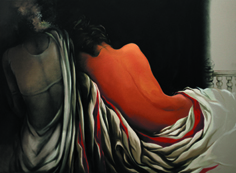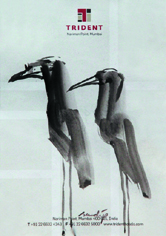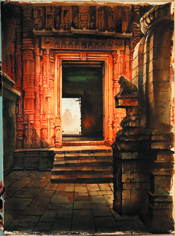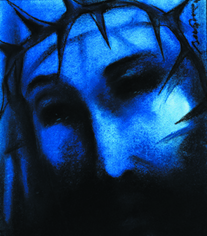 From soft watercolours to pencil drawings, from the sensuous figurative portraits of Tagore’s Charulata to metaphorical abstracts, from a tribute to Leonardo Da Vinci to the memories of Old Bengal school masters, Sudip Roy has captured it all. Titled Time Past is Present, this is an expansive show of over 70 odd works – on view at Art Positive in New Delhi from this Friday – which could well be termed the most ambitious art outing Roy has ever had.
From soft watercolours to pencil drawings, from the sensuous figurative portraits of Tagore’s Charulata to metaphorical abstracts, from a tribute to Leonardo Da Vinci to the memories of Old Bengal school masters, Sudip Roy has captured it all. Titled Time Past is Present, this is an expansive show of over 70 odd works – on view at Art Positive in New Delhi from this Friday – which could well be termed the most ambitious art outing Roy has ever had.
 What catches the eye first, and understandably so, is the enigmatic portrayal of Charulata, the bored, beautiful wife of a newspaper editor, the story of whose life was immortalised in Satyajit Ray’s film by the same name. On Roy’s canvas, Charulata becomes the protagonist whose intense loneliness is depicted in relationship to her only companion – the mirror. Roy never once shows the face of his muse, but evokes a sense of both an intriguing sensuality and the charming Bengali sophistication by focusing on his lady’s half draped back. He plays with the numerous folds of her sari, sometimes falling in a casual caress over a reclining body, sometimes revealing just enough to heighten the feeling of unspent passion. “She observes the activities of the outside world through the window blinds using opera glasses. She looks into the mirror to recognise herself. She is like a caged bird in her mansion. We sense her curiosity and desire to know the outside world,” says Roy.
What catches the eye first, and understandably so, is the enigmatic portrayal of Charulata, the bored, beautiful wife of a newspaper editor, the story of whose life was immortalised in Satyajit Ray’s film by the same name. On Roy’s canvas, Charulata becomes the protagonist whose intense loneliness is depicted in relationship to her only companion – the mirror. Roy never once shows the face of his muse, but evokes a sense of both an intriguing sensuality and the charming Bengali sophistication by focusing on his lady’s half draped back. He plays with the numerous folds of her sari, sometimes falling in a casual caress over a reclining body, sometimes revealing just enough to heighten the feeling of unspent passion. “She observes the activities of the outside world through the window blinds using opera glasses. She looks into the mirror to recognise herself. She is like a caged bird in her mansion. We sense her curiosity and desire to know the outside world,” says Roy.
 On the other end of the spectrum are the portraits inspired by Roy’s trips to Europe. “I have always been fascinated by the work of Leonardo da Vinci and his drawings and paintings became an integral part of my inspiration.” The subject he chooses is of Christ’s crucifixion and claims to have been especially inspired by Vinci’s The Last Supper. But he creates an amalgam here – of the ascension of Christ and the hint of The Last Supper by giving us the chairs and the fruits, and the ideation of ‘still life’ in the style of old Dutch Masters. One can gauge the influence of Italian Renaissance artists and their highly technical anatomical studies creating sculptural portrayals of the human figure. Roy brings that forward as well in semi-abstract studies of anatomical faces and torsos.
On the other end of the spectrum are the portraits inspired by Roy’s trips to Europe. “I have always been fascinated by the work of Leonardo da Vinci and his drawings and paintings became an integral part of my inspiration.” The subject he chooses is of Christ’s crucifixion and claims to have been especially inspired by Vinci’s The Last Supper. But he creates an amalgam here – of the ascension of Christ and the hint of The Last Supper by giving us the chairs and the fruits, and the ideation of ‘still life’ in the style of old Dutch Masters. One can gauge the influence of Italian Renaissance artists and their highly technical anatomical studies creating sculptural portrayals of the human figure. Roy brings that forward as well in semi-abstract studies of anatomical faces and torsos.

 The washes and watercolours in the show, on the other hand, embrace the lingua franca of the Bengal School. The use of light and shade, softness of the colour palette and the realistic impressions of landscapes and human figures create a world that exists both in our past and continues to delight our present. The series with works like City of Joy, Relic, The Door – a throwback to the forgotten heritage of Old Calcutta – moves between different periods of time. A few drawings done in the linear pencil and shade perspective stand out for their brilliance of execution and elegance. What makes Roy’s drawings stand out is his determination in the quest for decisive images. The artist takes a scene, a locale or an idea and creates an explicit vision of birds, animals, human forms and even still life. The compositions are simple and straightforward, a style of drawing that sums up a landscape or a form in just a few lines, even in the absence of colours.
The washes and watercolours in the show, on the other hand, embrace the lingua franca of the Bengal School. The use of light and shade, softness of the colour palette and the realistic impressions of landscapes and human figures create a world that exists both in our past and continues to delight our present. The series with works like City of Joy, Relic, The Door – a throwback to the forgotten heritage of Old Calcutta – moves between different periods of time. A few drawings done in the linear pencil and shade perspective stand out for their brilliance of execution and elegance. What makes Roy’s drawings stand out is his determination in the quest for decisive images. The artist takes a scene, a locale or an idea and creates an explicit vision of birds, animals, human forms and even still life. The compositions are simple and straightforward, a style of drawing that sums up a landscape or a form in just a few lines, even in the absence of colours.
What is present in abundance, though, is the vitality of an artist who can tell hundreds of stories with the same brush.
Poonam Goel is a freelance journalist and has covered the arts for over 15 years. She contributes on visual arts for various newspapers, magazines and online media. More about her on Story Wallahs. Write to her @ poonamgoel2410@gmail.com






Want to buy sudip’s art work.please send me images with price